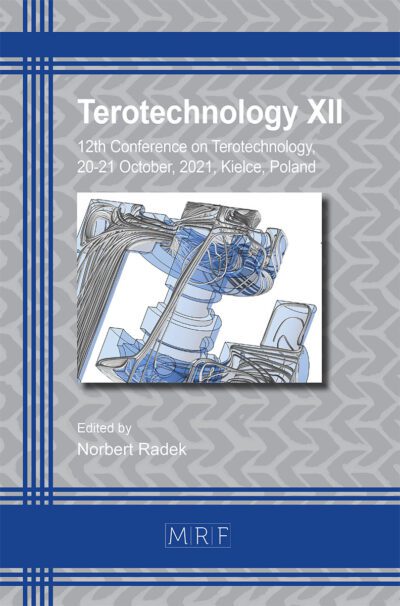Numerical study on cold extrusion of gears varying the extrusion shoulder geometry
DELIKTAS Tahsin, LIEWALD Mathias
download PDFAbstract. Cold forging processes, such as cold extrusion and in particular the Samanta process, provide a considerable potential for improvement in gears production. The method behind the Samanta process is based on the principle of cold extrusion in stacks. After partial forming of a workpiece, another workpiece is inserted into the die in order to eject a completely formed gear in the direction of the punch movement. Although this operating principle offers great potential for high-volume production, the industrial relevance of this process is limited by disadvantages such as high tool loads, limited gear accuracy and deformations on both face ends of the gear wheel. In order to overcome the technological challenges associated with the Samanta process, the die geometry was adapted. In this case the die operating surface was modified in terms of an extended forming zone length combined with an undercut in the tooth cavities of the die. In this paper the numerical results for this novel process regarding the correlations between geometric die parameters and resulting process data, such as punch force, contact pressure and die filling, are presented. The spline-based tool was methodically varied between one linear and two square (concave, convex) designs and was numerically evaluated using Deform 3D™ software.
Keywords
Metal Forming, Cold Forging, Gears, Simulation, Production Technology
Published online 4/19/2023, 10 pages
Copyright © 2023 by the author(s)
Published under license by Materials Research Forum LLC., Millersville PA, USA
Citation: DELIKTAS Tahsin, LIEWALD Mathias, Numerical study on cold extrusion of gears varying the extrusion shoulder geometry, Materials Research Proceedings, Vol. 28, pp 495-504, 2023
DOI: https://doi.org/10.21741/9781644902479-54
The article was published as article 54 of the book Material Forming
![]() Content from this work may be used under the terms of the Creative Commons Attribution 3.0 license. Any further distribution of this work must maintain attribution to the author(s) and the title of the work, journal citation and DOI.
Content from this work may be used under the terms of the Creative Commons Attribution 3.0 license. Any further distribution of this work must maintain attribution to the author(s) and the title of the work, journal citation and DOI.
References
[1] A. Schwager, M. Kammerer, K. Siegert, A. Felde, E. Körner, V. Szentmihalyi, Cold Forming of Helically Internal Toothed Wheels, in: New Developments in Forging Technology, 2003, pp. 489-503.
[2] C. Kiener, Kaltfließpressen von gerad- und schrägverzahnten Zahnrädern, Friedrich-Alexander-Universität Erlangen-Nürnberg, 2020.
[3] K. Lange, M. Kammerer, Fließpressen. Springer-Verlag Berlin Heidelberg, 2008. https://doi.org/10.1007/978-3-540-30910-9
[4] S. Samanta, M. Ypsilanti, Verfahren und Einrichtung zum Herstellen von Zahnrädern, Schutzrecht DE 25 33 670, 1975.
[5] W. Koll, W. König, Kaltfließpressen von Bauteilen mit Verzahnungen, in Präzisionsumformtechnik, Springer Berlin Heidelberg, 1990, pp. 193-213. https://doi.org/10.1007/978-3-642-95606-5_48
[6] T. Bausch, Innovative Zahnradfertigung-Verfahren, Maschinen und Werkzeuge zur kostengünstigen Herstellung von Stirnrädern mit hoher Qualität, 5. Auflage. Renningen: Expert Verlag, 2015.
[7] M. Merklein, C. Kiener, Researching of commonalities and differences in cold forging of spur and helical gears, Prod. Eng. 13 (2019) 391-397. https://doi.org/10.1007/s11740-019-00887-2
[8] M. Merklein, C. Kiener, R. Neher, Influence of tribological conditions on cold forging of gears, Prod. Eng. 12 (2018) 367-375. https://doi.org/10.1007/s11740-017-0785-9
[9] C. Kiener, K. Andreas, M. Merklein, Basic Numerical Analysis of a ‘ Samanta ’ Based Forward Extrusion Process, Adv. Mater. Res. 1140 (2016) 27-34. https://doi.org/10.4028/www.scientific.net/AMR.1140.27
[10] M. Liewald, T. Deliktas, Cold extrusion of spur and helical gears using a Guided Material Flow Process ( Modified Samanta Process ), in 52nd ICFG Plenary Meeting, 2019.
[11] R. Velu, M.R. Cecil, Quantifying Interfacial Friction in Cold Forming using Forward Rod Backward Cup Extrusion Test, J. Inst. Eng. Ser. C 93 (2012) 157-161. https://doi.org/10.1007/s40032-012-0018-0














